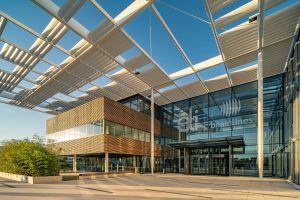First users at ELI Beamlines
In February 2019, the ELI Beamlines Laser Research Center addressed the scientific community to submit proposals for the implementation of research projects in the E1 experimental hall for research related to applications in molecular, biomedical and material sciences. This was the so-called Commissioning call – the very first call that the ELI Beamlines has launched for external users. Its main purpose was to launch and test four experimental stations by using technologies already in operation in the experimental hall E1. “The experimental hall E1 was conceived as a very variable space providing several unique scientific instruments using high-repetition laser sources and thanks to cooperation with external users we managed to put it into full operation,” says research program manager Jakob Andreasson.
The call met with a great success and several teams from all around the world (USA, Germany, Italy, Great Britain, Russia, Sweden, Poland, Hungary and the Czech Republic) were interested in experimenting at ELI Beamlines Facility. The research time at the facility was filled very quickly and the experiments are taking place between June and September 2019.
“This call and first successfully conducted experiments represent a real milestone for ELI Beamlines on the way to fulfil our mission to open up unprecedented opportunities for experiments to the worldwide scientific community,” adds Roman Hvězda, ELI Beamlines manager.
As an example can be mentioned that at the end of June, the end station ELIps dedicated to VUV ellipsometry received its first users within the commissioning call for E1. The user team was composed by two groups, the first one directed by Prof. Stefan Zollner from New Mexico State University, USA, and the second one directed by Dr. Luca Poletto from the Institute of Photonics and Nanotechnologies of Padova, CNR IT. During nine consecutive days they worked with an ELI experimental team headed by Shirly Espinoza, also containing staff from the HHG team directed by Jaroslav Nejdl, the Beamlines Integration Support team headed by Tomas Lastovicka and the L1 team headed by Pavel Bakule. The team carried out experiments on gold and silicon samples using energies between 31-70 eV. A second round of experiments will follow up the week of September 16-20 with experiments on germanium, nickel and strontium titanate samples.
Another user group of researchers came from Hungary. They did an experiment “Femtosecond Stimulated Raman Spectroscopy” which is a technique that allows to study molecular vibrations, motion, structure and chemical reaction mechanisms in time. The coordinator of this experiment was Miroslav Kloz from the ELI Beamlines experimental team for applications in molecular, biomedical, and materials sciences.
We would like to thank all members of the scientific community for their interest in ELI Beamlines capacities and to encourage other potential users to follow the developments at ELI Beamlines Facility and to be interested in developing of technologies and equipment we have. Already in the autumn of this year, we plan to announce additional calls for users. All information can be found at www.eli-beams.eu/users.
Extreme Light Infrastructure – ELI Beamlines
Source: ELI Beamlines
